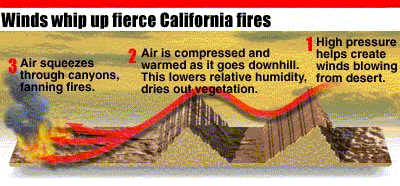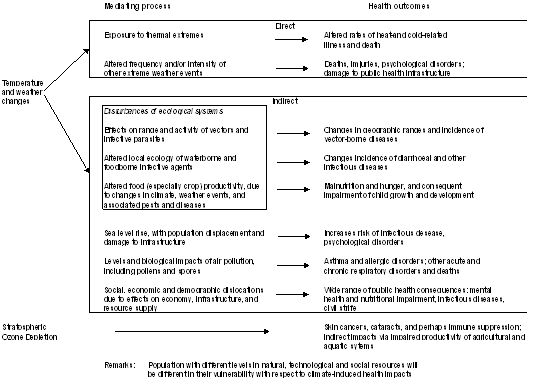
> ENC Master > Climate Encyclopaedia > Weather > more > 3. Biometeorology > -Weather and human health
|
|
 |
Weather
More |
More about weather and human health
|
 |
 |
|
1. source: http://www.es.mq.edu.au/ISB/
|
|
 |
Since ancient times, people have associated certain weather conditions with increases in pain, with headache or migraine or with simply feeling unwell. The connection between weather and health becomes clear, especially when a heat wave kills hundreds of elderly citizens or when the skin cancer rate increases dramatically recently.
Disorders resulting from heat and cold extremes and the sun's ultraviolet radiation are the obvious effects. Not so evident are the influences on our mood, behaviour and well-being. Researchers realized that medicine alone could not explain all ill effects and a new science was created: biometeorology, which is a combination of many science disciplines, mainly meteorology, medicine and biology. Our gradual detachment from nature and our modern lifestyle, with air conditioners, humidifiers and heaters has made us more sensitive to environmental influences. This is valid particularly when the body is weakened by illness or old age. |
The body reacts to cold by constricting the blood vessels in your skin and near the periphery of your body. So, the heart has to work harder to squeeze blood through the narrow vessels. This may be too much for a sick heart. A significant drop in barometric pressure leads to an expansion of air in isolated body cavities and of fluids in membranes. This can put pressure on the inflamed or injured tissues in joints or muscles, causing increased pain. Some people experience the same phenomenon during air travel when the cabin pressure drops during the take-off climb. Weather sensitivity pain could be caused by the irritation of nerve ends from rapid changes in weather elements. Also, bones and muscles have different densities, and the unequal expansion and contraction during temperature and humidity variations may increase the pain in inflamed or injured joints and muscles.
|
 |
 |
 |
|
2. Boiling water tossed into the air with temperature of -18 degrees on December 25. 2000.
Photo by Dan Lipinski
source: http://www.crh.noaa.gov/
with permission
|
|
 |
 |
|
3. source:
http://johnson.senate.gov/drought.html
|
|
 |
Hot weather extremes appear to have a more substantial impact on mortality than cold wave episodes. In summer 2003, up to 180 people dying in one day in Paris due to the abnormally high temperatures, and several thousands of people died during the heat wave. |
Humidity has an important impact on mortality since it contributes to the body's ability to cool itself by evaporation of perspiration.
|
 |
 |
 |
|
4. source:
http://www.petsit.com/data/publications/html/
world/ROOT-2001_6_27_145155.asp
|
|
 |
 |
|
5. Dust storm over Edwards Air Force Base
Photo by TSgt Matthew Kelpis
source: http://www.crh.noaa.gov/
with permission
|
|
 |
Weather-sensitive people may become irritated a day or two before the change and are often miserable when a weather front arrives. For example, hospital records in the US show that a greater number of babies are born during those weather conditions, headaches and migraines increase. Rheumatics dread the arrival of cold and damp weather, and the dry and dusty inland wind prior to the arrival of the front triggers asthma or aggravates the symptoms. Hayfever sufferers also know exactly when such a weather condition occurs.
|
The pre-frontal dry wind from the inland has similar properties to that experienced by the populations in Europe's alpine countries and in Canada and the US near the Rocky Mountains. These ill winds have a name, such as foehn in Central Europe and chinook and Santa Ana in North America. Some Swiss courts even allow the negative wind effects of these winds as a mitigating factor in crimes. The University of Calgary in Canada has substantiated the claims of many migraine sufferers that the chinook is their main trigger.
|
 |
 |
 |
|
6. Dry Santa Ana wind
source: http://www.usatoday.com/weather/wsanta.htm
|
|
|
Electrical storms also have an impact. A lightning bolt announces its presence by sending out electromagnetic signals, sferics (short for atmospherics), with the speed of light. Instruments can measure them hundreds of kilometres away.
|
 |
 |
|
7. Major types of impact change and stratospheric ozone depletion on human health (WHO/WMO/UNEP-Task Group, 1996)
|
About this pages:
author: Sándor Szalai - Hungarian meteorological service
scientific reviewing: Dr. Ildikó Dobi Wantuch / Dr. Elena Kalmár - Hungarian Meteorological Service, Budapest
last updated: 2004 - 02 - 12
|
References:
M. Kaiser: Weathering the seasons. Health & Medicine (31 July 2002)
Kalkstein, L. S., and K. M. Valimont. 1987. Climate effects on human health. In Potential effects of future climate changes on forests and vegetation, agriculture, water resources, and human health. EPA Science and Advisory Committee Monograph no. 25389, 122-52. Washington, D.C.: U.S. Environmental Protection Agency.
|
 > ENC Master > Climate Encyclopaedia > Weather > more > 3. Biometeorology > -Weather and human health
> ENC Master > Climate Encyclopaedia > Weather > more > 3. Biometeorology > -Weather and human health







